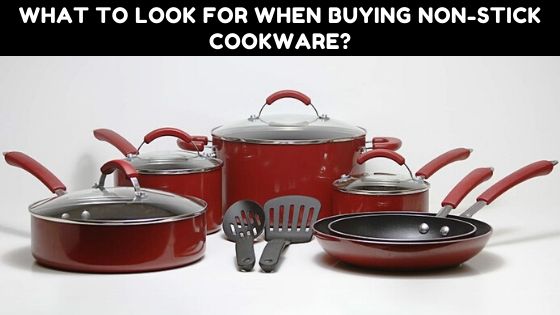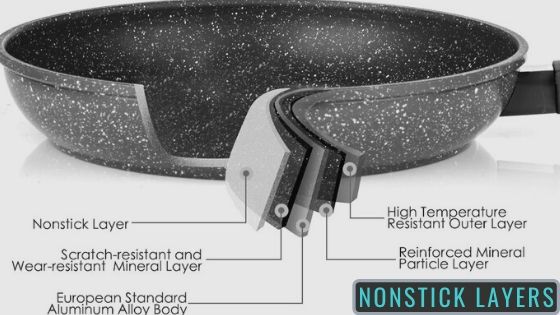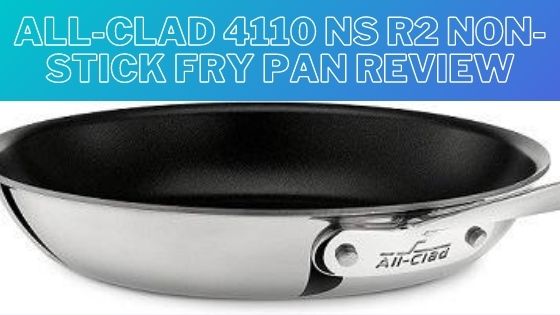When it comes to creating delicious and healthy meals, the importance of high-quality cookware cannot be overstated. Non-stick cookware, in particular, has gained immense popularity for its ability to prevent food from sticking and its ease of use.
However, not all non-stick cookware is created equal, and choosing the right set or individual pieces requires careful consideration. To ensure that you make an informed decision, it is crucial to know what to look for when buying non-stick cookware.
This comprehensive guide will walk you through the key factors to consider, empowering you to select cookware that not only meets your cooking needs but also ensures health, durability, and value for your investment.

Table of Contents
- 1 What To Look For When Buying Non-Stick Cookware?
- 2 Different Types Of Non-Stick Coatings
- 3 Different Types Of Non-Stick Cookware
- 4 Heat Distribution And Conductivity Of Nonstick Cookware
- 5 What To Look For In A Non-Stick Frying Pan?
- 6 Final Verdict
- 7 YOU MAY ALSO LIKE
- 8 FAQs
- 8.1 Is Non-Stick Cookware Safe To Use?
- 8.2 How Does The Number Of Metal Layers (Ply) Affect Non-Stick Cookware?
- 8.3 Can I Use Metal Utensils With Non-Stick Cookware?
- 8.4 How Should I Clean Non-Stick Cookware?
- 8.5 Are Non-Stick Coatings Prone To Peeling Or Scratching?
- 8.6 Can Non-Stick Cookware Be Used On All Types Of Stovetops?
- 8.7 How Long Does Non-Stick Cookware Typically Last?
- 8.8 Is Expensive Non-Stick Cookware Always Better?
What To Look For When Buying Non-Stick Cookware?
When buying non-stick cookware, look for a PFOA-free coating to ensure safety. Consider the build quality, including the number of metal layers (ply), for even heat distribution and durability. Check for a reliable non-stick surface coating and prioritize features like safety, durability, and value for money to make an informed decision.
Consider the following requirements when purchasing non-stick cookware:
- PFOA free.
- Build Quality (Construction).
- Surface Coating.
- Safety.
- Durability.
- Value for Money.
Now we will discuss briefly the topics which are listed above.
Also Read – Best Nonstick Pans for Gas Stoves
1. PFOA (Perfluorooctanoic Acid) Free Cookware
When you are going to buy any new non-stick cookware, always check for PFOA-free cookware. If they don’t mention it’s PFOA-free, then do not consider it at all.
But, nowadays, most of the cookware comes with PFOA-free as they don’t want to lose customers.

Why cookware needs to be PFOA-free?
PFOA is a man-made chemical that is designed to prevent sticking, heat, water, etc.
This chemical can be exposed if you are cooking at high heat, and exposure to this chemical may lead to harmful diseases including cancer. That’s why it is very important for cookware to be PFOA-free.
Also Read – Can You Put Your Non-Stick Pans In The Dishwasher?
2. Build Quality (Construction)
The quality of the cookware totally depends on the type of materials and processes used during manufacturing.
You often see 5-ply, 3-ply cladding when you are searching for cookware. What does this mean?
“Ply” means layers of metals that are present inside your non-stick cookware. These are usually sandwiched between stainless steel or different metals.

- Tri-Ply or (3-Ply) – Here three layers of metals like copper or aluminum are sandwiched between stainless steel.
- 5-Ply – It contains five layers of metals where two interior layers are heat conductive.
- 7-Ply – It contains seven layers of metals and four interior layers are heat conductive.
“Cladding” is usually a method of fabrication of metals. Here different types of metals are bonded to a single one. In the exterior, it has non-reactive metal followed by conductive metal in the interior to distribute the heat properly.
So when you are searching for any non-stick cookware, then try to purchase at least 5-Ply metal cladding. Because you will love cooking due to its better heat distribution and smoothness.
But, this simply does not mean that a higher ply will have higher quality. The overall quality, metal distribution, thickness, and of course the price will decide the cookware’s quality.
Also Read – How To Tell If A Pan Is Non-Stick?
3. Surface Coating
The coating of the cookware is extremely important as this will increase the overall quality and experience of the cookware.
Earlier or maybe some company today also puts PFOA coating which is very harmful as I have discussed earlier.
But, nowadays, the most popular coating is PTFE (Polytetrafluoroethylene), which is commonly known as Teflon. It is a man-made synthetic coating that resists water and sticking.
The other common type of coating is Ceramic, which is a silica-based gel.
Both of the coatings work very well to prevent any food from sticking or in the cleaning of the cookware.
You can choose any one of them as both work fine, but one thing Teflon coated lasts longer and Ceramic produces more healthy food.
4. Safety
The first and foremost thing is your safety. No matter what are you cooking, your cookware must be safe to operate.
The first thing is, as usual, it must be PFOA-free. If it is not, then the harmful chemical will mix up with the food and your health will be compromised.
The second thing is that your cookware should not be so thin, because in thin pans heat distribution is not that good. It may burn your food or even catch fire during cooking. That’s why according to science and cookware experts, we should use thick cookware.
Also Read – How To Get Sticky Residue Off Non-Stick Pans?
5. Durability
The durability of the pots and pans is extremely important as if you are spending 200 to 300 bucks on good quality cookware, then it should last longer.
When you are searching for new pots and pans, check their construction (at least 5-Ply), materials used, and scratch proof or not.
If all these check-boxes are marked and the brand is also good then definitely go for it. This type of pots and pans should last for a decade.
6. Value For Money
You have checked all criteria for buying a new set of pots and pans. Now the last thing comes to your mind that how much it will cost.
If you are thinking that good quality cookware will cost you a lot of money then you are wrong.
You cannot consider good quality cookware a waste of money, it’s an investment because you can make healthy food every day.
Quality pots and pans will easily cost you around $200 to $300 depending on the type of brand or from where you are purchasing.
But you should not consider non-stick cookware above $500 unless you are going for any copper or stainless steel or enameled cast iron cookware.
Here’s a chart summarizing the key factors to consider when buying non-stick cookware:
| Factors | Considerations |
| Non-Stick Coating Quality | PFOA-free coating |
| Build Quality | Number of metal layers (ply), durability |
| Heat Distribution | Even heat distribution for consistent cooking |
| Surface Coating | Reliable non-stick coating |
| Safety | PFOA-free, heat-resistant handles |
| Durability | Construction quality, scratch resistance |
| Value for Money | Balancing price with quality and features |
| Compatibility | Suitable for your stovetop type |
| Maintenance and Cleaning | Dishwasher-safe, easy-to-clean surface |
| Size and Weight | Choose based on cooking needs and preferences |
| Ergonomics | Comfortable and heat-resistant handles |
| Brand and Warranty | Trusted brand, warranty coverage |
You can check for our top picks
Different Types Of Non-Stick Coatings
When exploring non-stick cookware options, it’s important to be aware of the various types of coatings available besides the commonly known PTFE (Teflon) and ceramic coatings. Here’s a brief overview of a few alternative non-stick coatings:
- Diamond-Infused Coatings:
- Diamond-infused coatings are gaining popularity in the non-stick cookware market.
- These coatings incorporate tiny diamond particles into the non-stick surface, providing enhanced durability and scratch resistance.
- The addition of diamond particles can make the coating more resilient to metal utensils and abrasive cleaning, extending its lifespan.
- Diamond-infused coatings also offer excellent heat distribution, promoting even cooking.
- However, they can be more expensive compared to traditional coatings.
- Titanium Coatings:
- Titanium coatings are known for their exceptional durability and non-stick properties.
- These coatings are often applied in multiple layers to ensure a longer lifespan.
- Titanium-based non-stick cookware is highly resistant to scratches, making it suitable for use with metal utensils.
- It also allows for the easy release of food and facilitates quick cleanup.
- However, titanium coatings may have limitations in terms of heat resistance, and high heat may cause the coating to degrade over time.
- Ceramic-Reinforced Coatings:
- Some non-stick cookware features ceramic-reinforced coatings, which combine the benefits of ceramic and other materials.
- These coatings typically contain a mix of ceramic particles, as well as other reinforcing elements like titanium or diamond.
- Ceramic-reinforced coatings offer excellent non-stick properties and durability.
- They are often free of PFOA and other harmful chemicals, making them a healthier option.
- However, the quality and performance of ceramic-reinforced coatings can vary depending on the specific formulation and manufacturing process.
It’s important to note that each type of coating has its own set of advantages and considerations. Factors such as price, heat resistance, durability, and ease of maintenance should be taken into account when making a decision.
Additionally, it’s always recommended to follow the manufacturer’s instructions for proper usage and care to ensure the longevity of the non-stick coating.
When buying non-stick cookware, it’s a good idea to research and compare different coating types, read customer reviews, and consider your specific cooking needs and preferences.
By understanding the available options, you can make an informed decision and choose the non-stick coating that best suits your requirements.
Also Read – Does Vinegar Ruin Non-Stick Pans?
Different Types Of Non-Stick Cookware
When considering non-stick cookware, it’s important to be aware of the different types available and their specific considerations. Here’s a brief overview of common types of non-stick cookware and their uses:
- Frying Pans/Skillets:
- Frying pans, also known as skillets, are versatile cookware pieces used for a variety of cooking tasks.
- They feature a flat bottom and shallow sides, allowing for easy flipping and tossing of food.
- Frying pans are ideal for tasks like sautéing, frying, searing, and browning ingredients.
- They come in various sizes, ranging from small omelet pans to large family-sized pans, catering to different cooking needs.
- Sauce Pans/Saucepots:
- Saucepans are characterized by their tall, straight sides and a lid.
- They are commonly used for tasks like simmering sauces, boiling water, making soups, and cooking grains.
- The taller sides help prevent liquid from splattering while stirring, and the lids aid in heat retention and even cooking.
- Sauté Pans:
- Sauté pans have wide, flat bottoms and straight sides.
- They are designed for tasks that involve sautéing, stir-frying, browning, and tossing ingredients.
- The wide cooking surface allows for even heat distribution and ample space to accommodate larger portions of food.
- Griddles/Grill Pans:
- Griddles or grill pans feature a flat, smooth surface with ridges or raised patterns.
- They are ideal for cooking foods that benefit from grill marks or a seared appearance, such as steaks, burgers, vegetables, and even pancakes.
- The ridges help drain excess fat and create attractive grill marks on the food.
Also Read – How To Fix Scratched Non-Stick Pans?
Considerations For Different Cookware Types
- Size: Choose the size of each cookware type based on your cooking needs and the number of servings you typically prepare.
- Handles: Check for comfortable, heat-resistant handles that provide a secure grip and stay cool during stovetop use.
- Compatibility: Ensure that the cookware is compatible with your cooktop, whether it’s gas, electric, induction, or ceramic.
- Construction: Look for durable materials that offer even heat distribution and heat retention for optimal cooking performance.
- Lid: Depending on your cooking preferences, consider whether the cookware comes with a lid for better heat retention and versatility.
Investing in a well-rounded collection of non-stick cookware can expand your culinary capabilities and make meal preparation a breeze.
Also Read – How To Remove The Non-Stick Coating From Cookware?
Heat Distribution And Conductivity Of Nonstick Cookware
Heat distribution and conductivity are crucial factors to consider when purchasing non-stick cookware. The build quality and the number of metal layers (ply) play a significant role in determining how effectively heat is distributed throughout the cookware.
Understanding the impact of these factors can help users make an informed decision. Here’s a detailed explanation:
- Heat Distribution:
- Even heat distribution is essential for achieving consistent cooking results.
- When heat is evenly distributed across the cooking surface, it prevents hot spots or areas where the food may cook unevenly.
- With proper heat distribution, you can avoid situations where certain parts of your dish burn while others remain undercooked.
- Conductivity:
- The conductivity of the materials used in the construction of non-stick cookware affects how quickly and efficiently heat is transferred from the heat source to the food.
- Different metals have different conductivity properties. For example, copper is an excellent conductor of heat, while stainless steel is not as efficient. Aluminum falls somewhere in between.
- Non-stick cookware often incorporates layers of metals to enhance heat conductivity.
Also Read – Why Do Metal Handles Of Pans Get Hot?
Benefits Of Even Heat Distribution
Even heat distribution offers several benefits for cooking:
- Consistent Cooking: With even heat distribution, your food is more likely to cook uniformly, resulting in consistent flavors and textures throughout the dish.
- Prevention Of Hot Spots: Hot spots occur when certain areas of the cookware become significantly hotter than others. This can lead to uneven cooking, burning, or scorching of food. Proper heat distribution minimizes the occurrence of hot spots, ensuring that your food cooks evenly.
- Improved Cooking Performance: Even heat distribution enables better control over the cooking process. It allows you to cook at lower temperatures while still achieving desirable results. Additionally, it facilitates more precise cooking techniques such as searing, sautéing, or simmering.
- Reduced Cooking Time: When heat is evenly distributed, your cookware heats up more efficiently. This can help reduce cooking time, making meal preparation more efficient.
To ensure effective heat distribution and conductivity, non-stick cookware often features multiple metal layers.
For example, tri-ply cookware consists of three layers: an aluminum or copper core sandwiched between two layers of stainless steel. The combination of these metals promotes even heat distribution and efficient heat transfer.
It’s worth noting that the thickness and quality of the metal layers, as well as the overall construction of the cookware, can also impact heat distribution. Thicker cookware tends to distribute heat more evenly than thinner options.
Also Read – Best Non-Stick Cookware Brands
What To Look For In A Non-Stick Frying Pan?
When looking for a non-stick frying pan, there are several important factors to consider. Here are some key points to look for in a non-stick frying pan:
- Non-Stick Coating Quality:
- The quality of the non-stick coating is paramount.
- Look for pans with a durable and reliable non-stick coating that is PFOA-free.
- PFOA is a potentially harmful chemical that was commonly used in the production of non-stick coatings.
- Opting for a PFOA-free coating ensures the safety of your cookware.
- Construction And Durability:
- Consider the construction and durability of the frying pan.
- Look for pans made with high-quality materials such as stainless steel, aluminum, or copper.
- These materials offer good heat conductivity and durability.
- Additionally, check if the pan has a sturdy handle that stays cool during cooking and is securely attached to the pan.
- Heat Distribution:
- Efficient heat distribution is crucial for even cooking.
- Look for frying pans with multiple layers of metal or a thick base that ensures uniform heat distribution.
- This helps prevent hot spots and allows for consistent cooking results.
- Size And Weight:
- Consider the size of the frying pan based on your cooking needs.
- Frying pans typically range from 8 to 12 inches in diameter.
- Choose a size that suits the type and quantity of food you usually cook.
- Additionally, pay attention to the weight of the pan, as a heavier pan may provide better heat retention and stability.
- Handle Comfort And Ergonomics:
- A comfortable and ergonomic handle is essential for safe and convenient cooking.
- Look for frying pans with handles that offer a good grip and remain cool during stovetop use.
- Heat-resistant handles made of materials like silicone are preferable.
- Compatibility:
- Check the compatibility of the frying pan with your cooktop.
- Ensure that the pan is suitable for the type of stovetop you have, whether it’s gas, electric, induction, or ceramic.
- Not all pans work on all stovetops, so verify the compatibility before making a purchase.
- Maintenance And Cleaning:
- Consider the ease of maintenance and cleaning.
- Look for frying pans that are dishwasher-safe or have an easy-to-clean non-stick surface.
- Some pans may require handwashing or specific cleaning instructions, so check the manufacturer’s recommendations.
- Price And Warranty:
- Evaluate the price of the frying pan concerning its quality and features.
- While higher-quality pans tend to be more expensive, they often offer better performance and durability.
- Additionally, consider the warranty provided by the manufacturer, as it reflects their confidence in the product’s quality.
By considering these factors, you can choose a non-stick frying pan that meets your cooking needs, offers excellent performance, and ensures long-lasting durability. Remember to read customer reviews and compare different brands to make an informed decision.
Also Read – All-Clad 4110 NS R2 Non-Stick Fry Pan Review
Final Verdict
Choosing the right non-stick cookware is a crucial step in enhancing your cooking experience and promoting healthier meals.
By considering important factors such as PFOA-free coatings, build quality, surface coating, safety, durability, and value for money, you can make an informed decision that aligns with your cooking needs and preferences.
Investing in high-quality non-stick cookware ensures that you can prepare delicious meals without worrying about food sticking or harmful chemicals leaching into your food.
Additionally, cookware with even heat distribution and excellent conductivity allows for consistent cooking results and improved culinary techniques. Remember to select a size and weight that suits your needs, and opt for ergonomic handles that offer comfort and safety.
Regular maintenance and adherence to proper care instructions will help prolong the lifespan of your non-stick cookware.
Whether you’re a seasoned chef or a cooking enthusiast, the right non-stick cookware can elevate your culinary creations while providing convenience and ease of use.
YOU MAY ALSO LIKE
- How to Season a Nonstick Pan for First Time?
- How To Get Burnt Sugar Off A Pan?
- Tart Pan Substitutes
- How Many Mini Loaf Pans Equal A Regular Loaf Pan?
- Can You Bake A Cake In A Springform Pan?
FAQs
-
Is Non-Stick Cookware Safe To Use?
Non-stick cookware is generally safe to use when it is free of harmful chemicals like PFOA. Look for cookware labeled as PFOA-free to ensure your safety.
-
How Does The Number Of Metal Layers (Ply) Affect Non-Stick Cookware?
The number of metal layers in non-stick cookware impacts heat distribution and conductivity. More layers generally result in better heat distribution and more even cooking.
-
Can I Use Metal Utensils With Non-Stick Cookware?
It is generally recommended to use wooden, silicone, or other non-metal utensils with non-stick cookware to avoid scratching the non-stick coating. Check the manufacturer’s instructions for specific utensil recommendations.
-
How Should I Clean Non-Stick Cookware?
Non-stick cookware is often dishwasher-safe, but it’s best to consult the manufacturer’s guidelines. Handwashing with mild soap and non-abrasive sponges or cloths is generally recommended to prolong the life of the non-stick coating.
-
Are Non-Stick Coatings Prone To Peeling Or Scratching?
With proper care and usage, high-quality non-stick coatings should not peel or scratch easily. Avoid using metal utensils, abrasive cleaners, or harsh scrubbers that could damage the coating. Follow the manufacturer’s instructions for cleaning and maintenance.
-
Can Non-Stick Cookware Be Used On All Types Of Stovetops?
Not all non-stick cookware is compatible with all stovetop types. Check the product specifications to ensure compatibility with your specific stovetop, whether it is gas, electric, induction, or ceramic.
-
How Long Does Non-Stick Cookware Typically Last?
The lifespan of non-stick cookware can vary depending on usage, maintenance, and quality. High-quality non-stick cookware can last several years with proper care, while lower-quality options may need replacement sooner.
-
Is Expensive Non-Stick Cookware Always Better?
The price of non-stick cookware can vary based on brand, materials, and construction. While higher-priced options may offer better quality and durability, it is not always necessary to spend a fortune. Consider your budget and prioritize essential features like non-stick coating quality and heat distribution.
Katrina Smith is a seasoned expert with over 25 years of experience in all things related to cooking and the kitchen. As an avid cook and kitchen enthusiast, she is passionate about sharing her knowledge and expertise on cookware, kitchen appliances, kitchen tips, and kitchen staples.
Through her articles and reviews, Katrina aims to inspire and help others improve their cooking skills, experiment with different ingredients, and invest in quality cookware and appliances.

![How To Season And Clean Cast Iron Cookware? [4 Effective Ways] 5 How To Season And Clean Cast Iron Cookware](https://www.kitchensity.com/wp-content/uploads/2020/06/How-To-Season-And-Clean-Cast-Iron-Cookware.jpg)


![Stainless Steel Vs Nonstick Vs Ceramic Cookware Set [An Ultimate Guide 2023] 8 Stainless Steel vs Nonstick vs Ceramic Cookware Set](https://www.kitchensity.com/wp-content/uploads/2019/09/Stainless-Steel-vs-Ceramic-vs-Nonstick-Cookware-Sets-e1621083482728.jpg)

![What Pans Can You Use Cooking Spray On? [Ultimate Guide] 10 Types of pans with which cooking spray can be used](https://www.kitchensity.com/wp-content/uploads/2023/02/What-Pans-Can-You-Use-Cooking-Spray-On.jpg)